Insurgency in North-East- 1 | 1 Year Preparation for UPSC CSE PDF Download
Insurgency in North East
Geography of North East India
Geography of North East:
Northeast India is the eastern-most region of India. It is connected to East India via a narrow corridor (Siliguri corridor) squeezed between independent nations of Bhutan and Bangladesh.?
It comprises the contiguous Seven Sister States (Arunachal Pradesh, Assam, Manipur, Meghalaya, Mizoram, Nagaland, and Tripura), plus the Himalayan state of Sikkim.
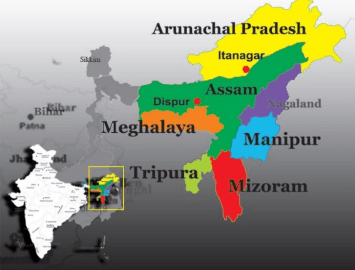 Comparative Status of North East
Comparative Status of North East
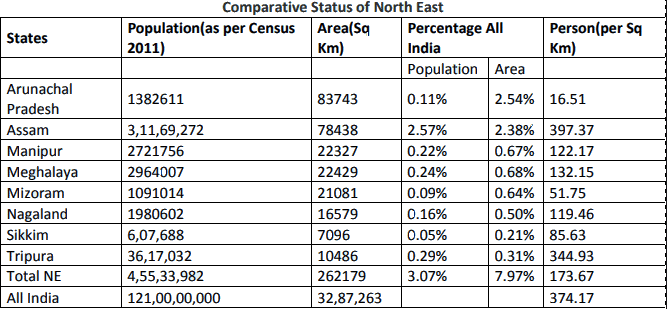
Strategic Importance:
Strategic Importance of North East: Northeast India has an extraordinarily important international strategic dimension and is a vital part of the nation’s defence architecture. Its importance is enumerated below:
International Border:
These states share their borders with other countries like Bangladesh, Bhutan, Myanmar and China. It makes up close to 40% of India’s land borders with its neighbours.
(i) Bridge to South East Asia: The region is at the crossroads of India and Southeast Asia. It is a bridgehead between India and the vibrant economies of Southeast Asia, including southern China.
(ii) Economic Significance: North East is endowed with huge natural resource (oil, gas, coal, hydro, fertile land, etc) which can be harnessed for nation development.
Overview of conflict in North East:
- India’s North east region has been land of thousand mutinies. These mutinies have been taking place since pre-independence times. The insurgencies in north east are a reflection of its social, cultural, ethnic and linguistic diversity, terrain, socio-econmic development, politico-economic conditions, historical evolution and changes in the environment of the area.
- A cursory look at the demographic mosaic of northeastern India would show that this region is home to a curious amalgam of cross-cutting societies. What compounds the problem of this plurality is the fact that the tendency for ethno-political assertion is high among almost all the groups. This is primarily because the political boundaries in most cases do not coincide with the existing social boundaries. The northeastern units of the Indian federation, in spite of several political permutations and combinations have not been able to cater to the demands of all the ethnic categories clamouring for recognition of their distinctive identity.
- This is reflected in the pattern of conflicts, which are varied in their nature and causes and the stance of insurgent groups which remain divergent and ever changing. These range from secession to autonomy, movements against foreigners and immigrants, ethnic integration and reaction to perceived imposition of Indianness. The common factor is resorting to violence in articulation and mobilization of the demands.
Conflicts in the region can be broadly grouped under the following categories:
- National conflicts: Involving concept of a distinct ‘homeland’ as a separate nation and pursuit of the realization of that goal by use of various methods both violent as well as non violent. Ex: ULFA demand for sovereign Asom, NSCN for Greater Nagaland.
- Ethnic conflicts: Involving assertion of numerically smaller and less dominant tribal groups against the political and cultural hold of the dominant tribal group. In Assam this also takes the form of tension between local and migrant communities.
- Sub-regional conflicts: Involving movements which ask for recognition of sub-regional aspirations and often come in direct conflict with the State Governments or even the autonomous Councils. Ex: UPDS in Assam.
General conditions favoring Insurgency:
- Large scale migration has created a fear in the minds of people that they will be reduced to minority in their own states or regions. Migrants threaten their culture and traditions and also occupy already limited employment opportunities. Migration of Muslims has also imparted it a communal color.
- Lack of economic opportunities and governance deficit making it easier for people to feel alienated and left out and thus providing support for insurgency.
- Porous international borders and easy availability of arms.
- Difficult terrain and weak infrastructure facilitating insurgents involved in conflict.
- Deep sense of alienation due to human right violation and excesses by security forces.
Insurgents groups in Northeast India:
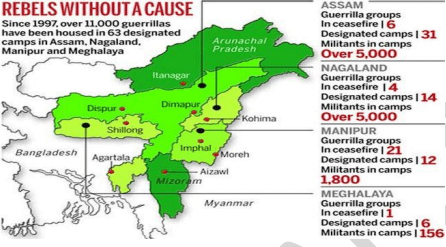
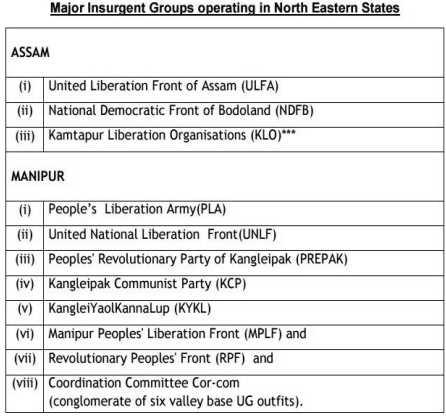
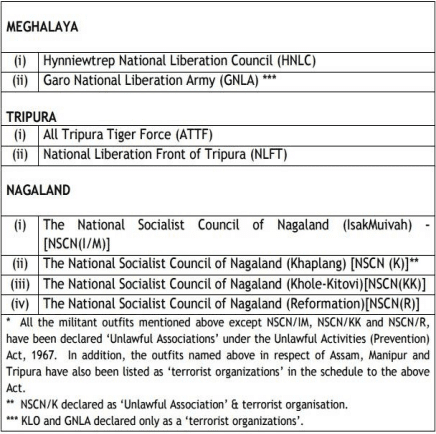
Reasons for conflicts (State-wise)
Assam:
- 1st state of NE India post 1947
- Radical turn in Assamese nationalism can be traced back to the influx of illegal migrants from East Pakistan after Partition in 1947 and later since 1971 onwards after the formation of Bangladesh
- Massive migrant flow created immense anxiety amongst the Assamese middle classes and the rural masses
- Violent protests erupted
- Assamese thought→ India is exploiting Assam’s oil
- Revenues from Assam’s other famous product—tea—were also going to the head offices located in West Bengal
- Most proximate cause of the Assam Agitation (1979-1985) was however malpractices in the electoral procedure in 1978
- All Assam Students’ Union (AASU) led an agitation demanding the 1951 National Register for Citizens be utilized to determine the citizenship of all those living in Assam
- State tried to use force and suppress the agitation
- Creation of one of the most persistent of violent ethnic movements in Assam—the United Liberation front of Asom(ULFA). 7 April 1979 -ULFA was formed on at Ranghar, in Sivasagar, a sight of historical significance since the time of the Ahom rule
- ULFA wants Assam’s status to the Ahom ruled Assam, pre-1826 treaty of Yandaboo between the British and the Burmese, which brought in British rule in Assam
- Recruits of the ULFA were drawn from the AsomJatiyabadiParishad (AJYCP)-SwadhinAsom→(Independent Assam).
- 3 September 2011, peace talk. Tripartite agreement for Suspension of Operations (SoO) against ULFA
- Signed between Indian Government, Assam government and ULFAJuly 2012, violence broke out with riots between indigenous Bodos and Bengali-speaking Muslims (who were suspected to be illegal Bangladeshi muslims).
- Violence in Assam later had its repercussions in other parts of India, Azad maidan riots in Mumbai, Rumour mongering (via sinister SMSs) triggered exodus of NE Indians.
Statehood demands in Assam
(i) Bodoland
(ii) KarbiAnglong
(iii) Dimaraji
(iv) Kamtapur
Post Telangana,revival of statehood movements by four ethnic groups — the Bodos, the Karbis, the Dimasas and the Koch-Rajbangshis
General reasons behind their demand of separate statehood
- To preserve and promote their ethnic identity
- For rapid economic development in backward areas
- To ensure control over natural resources like land
Bodoland
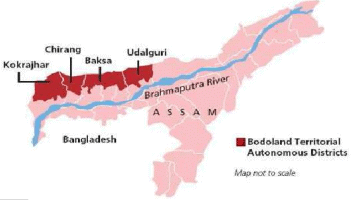
- Demand for state consisting of areas located extreme north of north bank of Brahmaputra river in the state of Assam, by the foothills of Bhutan and Arunachal Pradesh; inhabited predominantly by the Bodo people
- Bodoland Movement for an independent state of Bodoland started on March 2, 1987 under the leadership of Upendranath Brahma of the All Bodo Students' Union (ABSU)
The Bodoland Territorial Council (BTC)
- BTC has legislative, administrative, executive and financial powers over 40 policy areas in the Bodoland Territorial Areas Districts comprising four districts (Kokrajhar, Baksa, Chirang and Udalguri) of Assam.
- It was established in 2003 following a peace agreement between the Government of India and Bodo rebels and is functioning since 2003 under the provision of the Sixth Schedule of the Constitution of India
National Democratic Front of Bodoland
NDFB(Songjit faction) had turned up the fire in Assam in the year 2014, December by attacking districts of Sonitpur and Kokrajhar, killing nearly 78 and leaving many seriously injured. It appears that this carnage started in retaliation to the death of three NDFB (S) cadres during a counter-insurgency operation conducted by the Mahar Regiment on December 21 against the outfit’s camp in the Chirang District along the Assam-Bhutan border.
Causes of these recurring violence in the area:
- First, the political empowerment of the minority communities in the Bodo Territorial Area District (BTAD) in recent years has resulted in growing unease in the Bodo community. (i) The fear is about non-Bodo communities dominating the political process as seen in the election of Sarania.
- Second, political tension in the area is further compounded by the perception among the Bodos that illegal migration from Bangladesh is relegating them to a minority status in their own land. (changing demography)
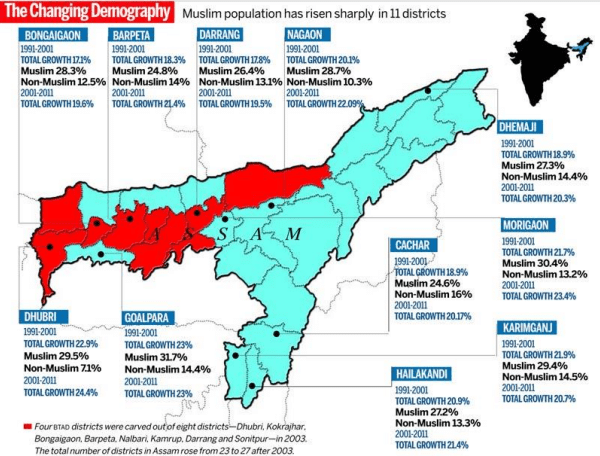
- Third, the ‘perception’ of massive illegal migration has generated a fear psychosis in the Bodo community that their ancestral lands will be illegally taken away by the migrants. The lack of any reliable data on the number of people migrating from Bangladesh into Assam further aggravates the situation.
- Fourth, the inclusion of illegal migrants in the voters list is viewed as a deliberate ploy to empower an outside group vis-à-vis the Bodos, so that the latter lose their distinct indigenous identity. This has created a siege mentality among Bodos.
The situation has been further compounded by the failure of the Bodo Territorial Council (BTC) to mitigate the fears of the Bodos.
- For instance, the Bodo Accord of 2003 clearly stated that the BTC will “fulfill the economic, educational, and linguistic aspirations and the preservation of land-rights socio-cultural and ethnic identity of the Bodos.” Despite these provisions the Bodos continue to feel insecure vis-à-vis the minority communities due to weak administrative institutions that have failed to lock in their rights.
The divisive politics of the members of the BTC have also added to the insecurity.
- For example, in May 2012, the BTC Chief HagramaMohilary had accused the minority representative in the BTC, KalilurRehman of the Congress, of instigating the minority community against the Bodos, which had led to the death of nearly 96 people (both Bodo and non-Bodo), without offering concrete evidence to back up his claims.
- The BTC has failed to assuage the fears of the non-Bodos too. In terms of composition, the BTC has 46 seats of which 30 are reserved for Scheduled Tribes (read Bodos), five for non-tribals, five are open to all communities and the remaining six are to be nominated by the governor of Assam from among the communities.
- In a Council, where policy decisions in terms of development packages, land revenue, business tax and so on are based on a majority vote, it is clear that the Bodos are the privileged lot. The BTC is also vested with powers under the Panchayati Raj system.
- While the Bodo Accord explicitly states that the non-tribal population will not be disadvantaged by the provisions of the Accord, in reality, their rights are not duly acknowledged by the BTC, creating enormous apprehensions.
The final cause of the recurring violence is the existence of armed groups like the NDFB-S, the Birsa Commando Force (BCF) representing the Santhals, etc., which have the capability to challenge the authority of the state administration.
The way out
- establish a land record system that is computerised and accessible to the local people, and which can address the fear of loss of land to the outsiders.
- Improve the presence of both the state civil administration and the law enforcement agencies in areas that are identified as highly susceptible to ethnic violence.
- The state and union governments need to work together to collate credible data on the flow of migrants into areas that have been included in the BTAD.
Assam Nagaland Border Crisis
More than 20 protestors were injured and two killed in police action at Rangajan, Golaghat District, Assam against an economic blockade on Asian Highway 1 (also called NH 39) leading into neighbouring Nagaland. (2014)
Major Groups involved were:
(i) Asom Jatiyatabadi Yuva Chhatra Parishad,
(ii) All Assam Tea Tribes students Association,
(iii) All Assam Tai Ahom Students Union, and
(iv) All Adivasi Students Association
The Assam-Nagaland border is disputed since Nagaland achieved statehood in 1963. The disputed land is claimed by private individuals and communities on both sides of the official border based on historical rights in the absence of bona fide documents. In spite of the Supreme Court’s intervention, the dispute remains unresolved with an interim agreement between Assam and Nagaland to place the disputed border areas under the control of a neutral Central Police force.
 |
Download the notes
Insurgency in North-East- 1
|
Download as PDF |
Karbi Anglong
- Government has created Autonomous hill districts of Assam in Mikir hills
- Demand Separate state of KarbiAnglong (Homeland) is being made by people of Karbi tribe
- Karbi Anglong district is the largest amongst the 27 administrative districts of Assam
- 2006- Indian government named KarbiAnglong one of the country's 250 most backward districts
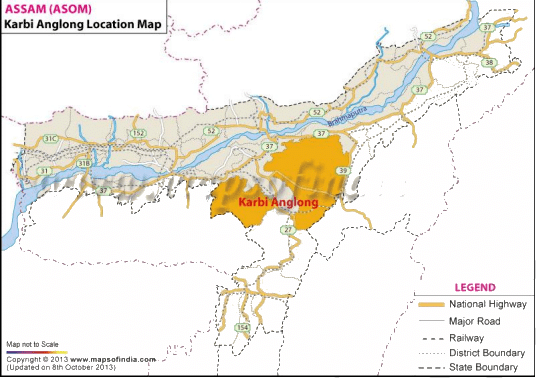
Dimaraji
Dimsa people demanding a separate state called Dimaraji or "Dimaland" comprise the Dimasa inhabited Areas
- -DimaHasao district,
(i) parts of Cachar district,
(ii) parts of Nagaon district and
(iii) KarbiAnglong district in Assam together with
(iv) Part of Dimapur district in Nagaland
Government has created The Dima Hasao Autonomous Council (DHAC) in response to the demands.
Kamtapur
They do not have an autonomous council
Demand of state in North West Bengal and Assam by the Koch Rajbanshis (Rajbongshis) people some districts of West Bengal + districts of Assam.
areas demanded under Kamatapur also overlap the areas which were demanded under the statehood of Gorakhland
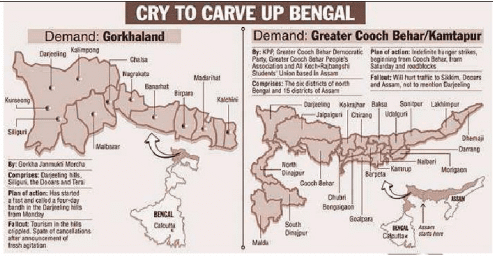
Conflict:
Rajbanshis-Gorkha Rajbanshis-BodoInsurgency: Kamtapur liberation Organisation
The KLO is contrastingly clear in its cessationist demand and is campaigning for restoration of the so-called past independence of a notional Koch Kamta kingdom, which existed during the 12th to the 15th century under the control of the Khen dynasty, with capital near Moynaguri in present Alipurduar sub-division of Jalpaiguri district. The KLO`s activities encompass the six districts of north West Bengal and Kokrajhar, Bongaigaon, Dhubri and Goalpara districts of west Assam.
Recent developments
- Currently, one faction of ULFA (ArabindaRajkhowa) is talking with government and they have dropped their demand of sovereignty. However another faction led by PareshBarua has rejected the talks.
- Assam has been affected by insurgent movements initiated by Karbi and Dimasa tribes, the Adivasis and also the Islamists. Karbi and Dimasas have demanded autonomy for their homelands whereas the Adivasis have demanded greater recognition of their rights. Many small outfits like ‘Dima Halam Daogah’ have also started demanding autonomy in their areas.
- Violence in 2012 on communal lines and recent protests for complete statehood post Telanagna formation has kept the region disturbed. Bodos are not satisfied as their complete demand of statehood has not been met while other communities inhabiting the region resent the dominance of Bodos, thus peace remains fragile.
- Assam also faces challenge on Maoist front. Maoist presence has been noticed in Assam and border areas of Arunachal Pradesh and several maoist leaders have been arrested from Assam.
- In light of above factors government has imposed AFSPA in Assam and continues to be in force. (till January 2016 it is still in force)
- UPDS (United People’s Democratic Solidarity) signed Memorandum of settlement (MoS) on 25.11.2011 and subsequently dissolved itself.
- DHD (Dima Halam Daogah) which signed the MoS on 8th October, 2012 has also subsequently dissolved itself.
- ULFA (United Liberation Front of Assam) talks are continuing. Last meeting on 15.5.2015. Suspension of Operation( SoO )is valid from 3.9.2011 and is continuing indefinitely.
- NDFB(P) [National Democratic Front of Boroland (progressive)] singed the Suspension of Operation (SoO) agreement first on 1.6.2005 and is presently valid upto31.12.2015.
- NDFB (RD) [National Democratic Front of Boroland (RanjanDaimairy] a splinter group of NDFB has signed Suspension of Operation( SoO ) agreement on 29.11.2013. SoO is valid upto 30.9.2015.
- KarbiLongri NC Hills Liberation Front (KLNLF) is presently under Suspension of Operation( SoO ) agreement with the Government w.e.f. 11.2.2010.
- 9 Adivasi outfits surrendered on 24.1.2012. Their demands are being discussed.
Manipur:
- Kingdom of Manipur was merged with the Indian Union on 15 October 1949. However, only after a protracted agitation interspersed with violence, it was declared a separate state in 1972.
- The emergence of insurgency in Manipur is formally traced to the emergence of the United National Liberation Front (UNLF) on 24 November 1964. The alleged ‘forced’ merger of Manipur and the delay in the conferring of full-fledged statehood to it was greatly resented by the people of Manipur.
- Since then several other outfits, like the People's Liberation Army (PLA), founded on September 25, 1978, People's Revolutionary Party of Kangleipak (PREPAK) set up on October 9, 1977 and the Kangleipak Communist Party (KCP) that came into being in April, 1980 have emerged in the valley areas consisting of four districts of the State.
- All these insurgent groups have been demanding a separate independent Manipur.
- From Nagaland, violence by the Naga groups has also spilled over into Manipur, a substantial part of which is claimed by the Isak-Muivah faction of National Socialist Council of Nagaland (NSCN-IM) as part of Nagalim, the proposed unified territory of the Nagas as claimed by the Naga rebels. Several clashes between the NSCN-IM and the Khaplang faction of National Socialist Council of Nagaland (NSCN-K) have been reported from the hill districts of the State.
- Kuki tribals in the early 1990s initiated their own brand of insurgency against the alleged oppression by the NSCN-IM. Following ethnic clashes between the Nagas and Kukis in the early 1990s, a number of Kuki outfits were formed. Several other tribes, such as the Paite, Vaiphei and Hmars have also established their own armed groups. Similarly, Islamist outfits like the People’s United Liberation Front (PULF) have also been founded to protect the interests of the ‘Pangals’ (Manipuri Muslims).
- Today, Manipur is one of the worst affected states in the Northeast where at least 12 insurgent outfits are active at present. A report of the State Home department in May 2005 indicated that ‘as many as 12,650 cadres of different insurgent outfits with 8830 weapons are actively operating in the State’.
- According to government sources, the strength of those concentrated in the valley districts, is assessed at around 1500 cadres for the Revolutionary People’s Front (RPF) and its army wing, the PLA, 2500 cadres for the UNLF and its army wing Manipur People’s Army (MPA), 500 cadres for the PREPAK and its army wing Red Army, while Kanglei Yawol Kanna Lup (KYKL) and its Yawol Lanmi army is assessed as having a strength of 600 cadres. The Kangleipak Communist Party (KCP)’s strength is assessed at 100 cadres.
- The UNLF, PLA, KYKL, PREPAK and the KCP have been involved in some of the serious attacks on security forces. The insurgents have an avowed policy of not targeting the state police personnel, unless circumstances demand it. The practice of directing their attack on the Army and the central para-military personnel is an attempt to create a divide between Manipur and India and to secure vital popular support.
- Unlike other conflict theatres of the Northeast, not many ‘surrenders’ have been reported from Manipur, thus indicating the tight control that the outfits have maintained over their cadres. Armed with an extremely efficient intelligence network and superior fire power, the militants have been able to carve out a number of liberated zones across the State.
- Manipur had been declared a ‘disturbed area’ in its entirety in 1980 and the Armed Forces Special Power Act (AFSPA) 1958 was imposed in the State on 8 September, 1980, which continues to be in place till now. The implementation of this Act resulted in the State witnessing an unprecedented civic uprising, including the infamous “mothers’ nude protest” and Irom Sharmila protest against the Act .The AFSPA is still embroiled in controversy and the people of Manipur are continuing their protest against the Act.
In short, Manipur continues to be an active arena for a multiplicity of violent conflicts. Further lack of industrialization and economic development has not helped either.
Recent Development:
June 4, 2015 Incident:
18 Indian Army jawans were killed and several others were injured when suspected militants ambushed their convoy in Manipur's Chandel district.
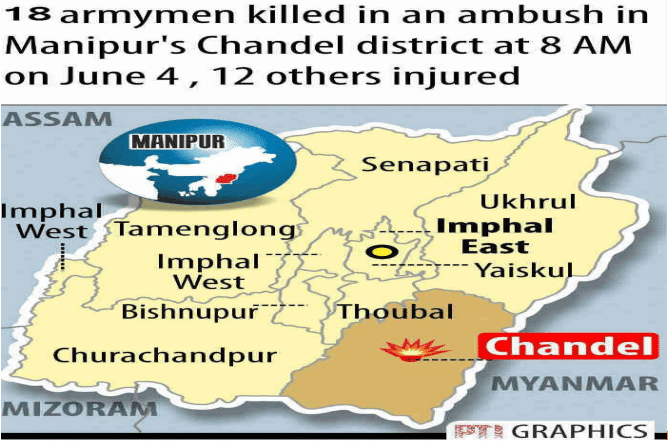
n response to the killing of 18 of its troops by militants in Manipur, the Indian Army in one of its biggest covert missions sent troops into Myanmar to strike at two camps and, according to official estimates, killed over 20 suspected militants.

Inner Line Permit controversy in Manipur
Manipur witnessed a series of protests starting in July 2015, following demands for the implementation of the Inner Line Permit (ILP) system in the State. The protesters have demanded that the government introduce the ILP bill in the State Assembly. If the bill is passed and enacted into law, it will require outsiders to obtain a special pass or permit to enter the State. The system is in force in the neighbouring States of Nagaland and Mizoram and also in Arunachal Pradesh.
What is the Inner Line Permit?
- The Inner Line Permit (ILP) is an official travel document issued by the Government of India to grant inward travel of an Indian citizen into a protected area for a limited period. It is obligatory for Indians residing outside those states to obtain permission prior to entering the protected areas.
- Currently, the Inner Line Permit is operational in Arunachal Pradesh, Mizoram and Nagaland.
- The document has been issued under the Bengal Eastern Frontier Regulation, 1873 and the conditions and restrictions vary from state to state.
- The system was introduced by the British to protect their commercial interests, particularly in oil and tea, and continues now essentially as a mechanism to firewall the tribal peoples and their cultures from onslaughts by outsiders.
The history of ILP in Manipur
The ILP in Manipur region remained in force until 1950, when it was revoked by the then Commissioner of Assam, whose jurisdiction also covered Manipur. Since Manipur, which attained Statehood in 1972, is not officially a tribal State, there are constitutional challenges to implementing the ILP system.
Who is protesting?
Among the three major communities of Manipur — Meitei, Kuki, Naga — the ILP system has been demanded only by the Meiteis. The Kuki population is wary of the motives of the ILP campaign. The apprehension has recently been heightened by the fact that some within the Meitei community have called the Kukis ‘foreigners’. Though the Kukis are an indigenous group in Manipur, there are some who fear that the Meiteis could use the ILP to advance their stand of Kukis being foreigners. This seems to be an important reason why many within the Kuki community do not support the ILP or the Meiteis’ demand for tribal status.
Government Response:
After few months of protests of Meitei for Inner Line Permit system to prevent "outsiders" from buying land or settling in the state, the state assembly passed three bills to give more rights to indigenous groups. This was followed by counter protests by the Kukis and Nagas to withdraw the bills resulting in violence and deaths. The tribal groups claim that the new bills, would allow Meiteis to buy land in the hill districts of Manipur where the Nagas and Kukis live. Further they argue that these bills were passed without consulting them. This has led to a tense situation till now.
Concerns over Naga Accord:
NSCN (IM) in its recent peace accord with has given up its demand for Greater Nagaland providing much relief to the Manipuris. But the Khaplan faction still continues to resort to violence and was involved in the attack on the Indian Army along with ULFA and Bodo groups in Manipur in June killing 20 jawans. This was followed by India’s hot pursuit in the Myanmar territory killing about 50 terrorists.
Possible Solution:
One possible amicable solution for the government is to implement the Sixth Schedule in the hill areas. Under such a political arrangement, the Kukis and Nagas would enjoy autonomy in their respective areas but remain within the State of Manipur.
|
1090 videos|2974 docs|1354 tests
|
FAQs on Insurgency in North-East- 1 - 1 Year Preparation for UPSC CSE
| 1. What is the main cause of insurgency in North East India? |  |
| 2. Which are the major insurgent groups operating in North East India? |  |
| 3. How does insurgency affect the socio-economic development of the region? |  |
| 4. What measures has the government taken to address the insurgency issue in North East India? |  |
| 5. What are the prospects for peace and stability in North East India? |  |























